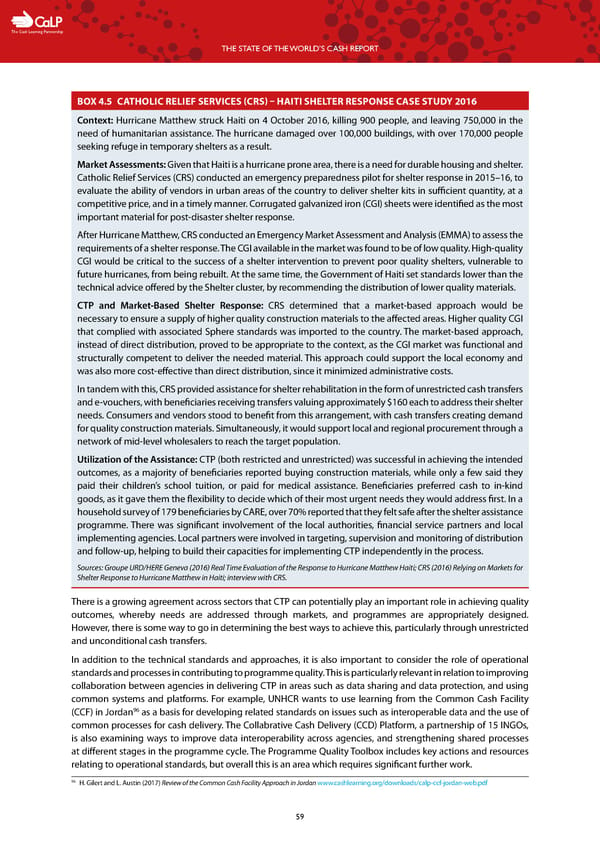C The Cash Learning Partnership THE STATE OF THE WORLD’S CASH REPORT BOX 4.5 CATHOLIC RELIEF SERVICES (CRS) – HAITI SHELTER RESPONSE CASE STUDY 2016 Context: Hurricane Matthew struck Haiti on 4 October 2016, killing 900 people, and leaving 750,000 in the need of humanitarian assistance. The hurricane damaged over 100,000 buildings, with over 170,000 people seeking refuge in temporary shelters as a result. Market Assessments: Given that Haiti is a hurricane prone area, there is a need for durable housing and shelter. Catholic Relief Services (CRS) conducted an emergency preparedness pilot for shelter response in 2015–16, to evaluate the ability of vendors in urban areas of the country to deliver shelter kits in sufficient quantity, at a competitive price, and in a timely manner. Corrugated galvanized iron (CGI) sheets were identified as the most important material for post-disaster shelter response. After Hurricane Matthew, CRS conducted an Emergency Market Assessment and Analysis (EMMA) to assess the requirements of a shelter response. The CGI available in the market was found to be of low quality. High-quality CGI would be critical to the success of a shelter intervention to prevent poor quality shelters, vulnerable to future hurricanes, from being rebuilt. At the same time, the Government of Haiti set standards lower than the technical advice offered by the Shelter cluster, by recommending the distribution of lower quality materials. CTP and Market-Based Shelter Response: CRS determined that a market-based approach would be necessary to ensure a supply of higher quality construction materials to the affected areas. Higher quality CGI that complied with associated Sphere standards was imported to the country. The market-based approach, instead of direct distribution, proved to be appropriate to the context, as the CGI market was functional and structurally competent to deliver the needed material. This approach could support the local economy and was also more cost-effective than direct distribution, since it minimized administrative costs. In tandem with this, CRS provided assistance for shelter rehabilitation in the form of unrestricted cash transfers and e-vouchers, with beneficiaries receiving transfers valuing approximately $160 each to address their shelter needs. Consumers and vendors stood to benefit from this arrangement, with cash transfers creating demand for quality construction materials. Simultaneously, it would support local and regional procurement through a network of mid-level wholesalers to reach the target population. Utilization of the Assistance: CTP (both restricted and unrestricted) was successful in achieving the intended outcomes, as a majority of beneficiaries reported buying construction materials, while only a few said they paid their children’s school tuition, or paid for medical assistance. Beneficiaries preferred cash to in-kind goods, as it gave them the flexibility to decide which of their most urgent needs they would address first. In a household survey of 179 beneficiaries by CARE, over 70% reported that they felt safe after the shelter assistance programme. There was significant involvement of the local authorities, financial service partners and local implementing agencies. Local partners were involved in targeting, supervision and monitoring of distribution and follow-up, helping to build their capacities for implementing CTP independently in the process. Sources: Groupe URD/HERE Geneva (2016) Real Time Evaluation of the Response to Hurricane Matthew Haiti; CRS (2016) Relying on Markets for Shelter Response to Hurricane Matthew in Haiti; interview with CRS. There is a growing agreement across sectors that CTP can potentially play an important role in achieving quality outcomes, whereby needs are addressed through markets, and programmes are appropriately designed. However, there is some way to go in determining the best ways to achieve this, particularly through unrestricted and unconditional cash transfers. In addition to the technical standards and approaches, it is also important to consider the role of operational standards and processes in contributing to programme quality. This is particularly relevant in relation to improving collaboration between agencies in delivering CTP in areas such as data sharing and data protection, and using common systems and platforms. For example, UNHCR wants to use learning from the Common Cash Facility 96 (CCF) in Jordan as a basis for developing related standards on issues such as interoperable data and the use of common processes for cash delivery. The Collabrative Cash Delivery (CCD) Platform, a partnership of 15 INGOs, is also examining ways to improve data interoperability across agencies, and strengthening shared processes at different stages in the programme cycle. The Programme Quality Toolbox includes key actions and resources relating to operational standards, but overall this is an area which requires significant further work. 96 H. Gilert and L. Austin (2017) Review of the Common Cash Facility Approach in Jordan www.cashlearning.org/downloads/calp-ccf-jordan-web.pdf 59
 The State of the World's Cash | Full Report Page 60 Page 62
The State of the World's Cash | Full Report Page 60 Page 62